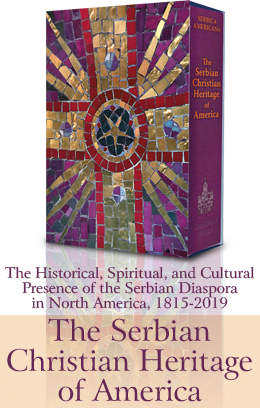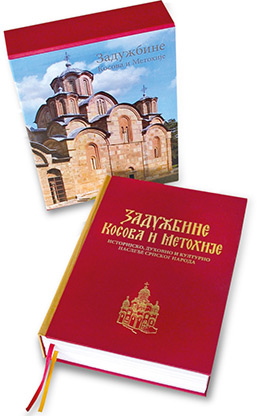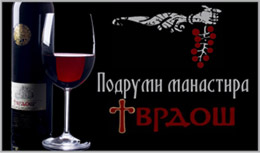By Very Reverend Dr. Radomir Popovic
BEGINNINGS
Serbs belong to the grand family of Slav nations. As early as 5th and 6th centuries AD they migrated from their ancient lands in Northern Europe to the Balkan Peninsular which, at the time, constituted northern regions of the Byzantine Empire. There they found a mostly deserted, devastated and pillaged territory since, prior to their arrival, it had been affected by the Grand Migration of the Euro-Asian peoples in 4th and 5th centuries AD.
Being pagan, the South Slav nations considerably contributed towards the destruction of the Christian Church organization which, in its turn, had functioned well on the Balkan Peninsular several centuries before their arrival.
It is without doubt that first Christian influences on the Serbs occurred after their arrival to the Balkans. Of course, Serbs were not the first pagan nation in this region to have come into contact with Christianity; one should also mention the Goths, Huns, Langobards, Avars, Gepids, Herulians…
Very early upon their arrival Slavs, i.e. Serbs inhabiting northern regions of Byzantium, had shown willingness to stay in the area indefinitely. This decision to stay might have been taken during the rule of Emperor Justinian (527-565) if not even earlier.
Adoption of Christianity in the already mostly Christianised Europe was, as far as the Slav tribes were concerned, a long and a complex process, but, at the same time, an unavoidable one. The neighbouring environment of Serbs, Bulgars, Croats and others had become Christian centuries before. Being pagan, these Slav nations sharply stood out against this christianized milieu and it was only a matter of time and circumstances before they also would become Christian.
According to a Byzantine writer, the emperor-historian Constantine VII (913-959), Serbian tribes adopted the new faith very slowly, i.e. it took them quite a while to renounce their ancient pagan customs and convictions. Same author recorded that the first occurrence of an en-masse baptism among the Serbs happened during the reign of Emperor Heraclius (610-641). First Christian missionaries among the Serbs came from the East, arriving from renowned Byzantine Christian and spiritual centres such as Constantinople and Thessalonica. However, there is no doubt that Christian influences also arrived from Adriatic coastal towns where, despite barbarian devastations, a pre-Slav church organization still remained well intact.
Serb tribes were finally all baptized after spending more than two hundred years in their newly inhabited homeland; Christian faith and Church organization developed to such an extent that it was not possible to talk about Christian spirituality and culture in the real sense of those words. In other words, it is possible to follow a historical development of Christianity among Serbs as a Christian European nation. Serb adoption of Christian faith ran parallel to the process of the establishment of their first organized state during the first half of 9th century. Christian and spiritual enlighteners of Serbs, as well as other Slav nations, were the Holy brothers Cyril and Methodius - Equals to the Apostles. It is thought that the baptism of Serbs occurred during the reign of Knez Mutimir (before the year 891). Bulgars had been baptized several years prior to that point in time. This was the time of the rise of the Frankish medieval state in Western Europe and, simultaneously, the rise in grand power of the bishops of Rome, i.e. the popes. It is precisely around this time that the ambitious pope Nicholas I (+867) tried, with the aid of the Franks, to subdue the whole of Balkan Peninsular and place it under the spiritual jurisdiction, which he had been deprived of back in 732 owing to the iconoclastic crisis within the Church itself. Immediately after, or simultaneous to the baptism of Bulgars in 864, the Christian mission of the Holy brothers in Moravia - the state of Knez Rastislav - took place.
That which crucially effected baptism of not only the Serbs but also other Slav nations was the invention of the Slavonic script, i.e. Glagolitic and Cyrillic alphabet, around the middle of the 9th century. Beginnings of literacy among Slavs are closely connected with their adoption of Christianity in their own popular language. It has rightly been said long ago that the very first words written in Slav language and script came from the Bible: "In the beginning was the Word, and the Word was with God. And the Word was God; and without Him nothing was made that was made…" (John I;1-3). Bible was immediately translated from Greek into Slavonic, as were all the necessary ecclesiastical offices, i.e. service books. Therefore, in-depth christianization of the Slavs began not in Greek language or, even less so, in Latin but in the popular Slavonic language, the language and the script that would soon become third (after Greek and Latin) on the list of the most commonly used languages in the contemporary world.
It is also an important fact that the Serbs adopted Christianity during the reign of Knez Mutimir, when Emperor Basil I the Macedonian (867-886) ruled Byzantium, and when Photius was Patriarch of Constantinople. It was Photius who blessed the Holy brothers and their disciples in their endeavour to christanise the South Slavs. It had been rightly said that Photius had become the Godfather of all Slavs. It should be said that there was a real threat at the time that all newly baptised South Slav nations: Serbs, Bulgars, Croats would be placed under Roman, i.e. Papal, spiritual jurisdiction. This was eventually accomplished with Croats.
First dioceses in Serbian lands are mentioned in 9th century. In 878 Beograd we have bishop Sergius, whilst in the Dicoese of Branicevo (Branychevo) we have another Slav, bisho Agathon. Some time later, in 10th century, documents mention bishops in Ston, Ras, Lipljan (Liplyan), Nis (Nish), Prizren and some other towns which had been bishoprics even before the arrival of Slavs.
Consolidation of Christianity among the Serbs before the age of St. Sava owed its success to the fact that Church services and sermons were delivered in the popular language of the time, which was the only one understood by the public at large. After the death of St. Methodius, bishop of Pannonia (885), Frankish-Latin clergy expelled his disciples from Moravia, reason being that these disciples did not agree to preach Christian faith in Latin. It should be remembered that Latin was a language foreign to the local population. Thus, the expelled disciples of Cyril and Methodius suddenly found themselves in those Balkan regions that were occupied by Bulgars, Serbs, and Croats. Prominent among them were Clement and Naum, both of whom were active for several decades in the regions of Lakes Ohrid (Ochrdi) and Prespa. They nurtured and developed Slavonic literacy, educated and trained native clergy who, in their turn, went among ordinary people and thus conveyed faith to the local population.
"Diocese of Velic" (Velich) is the first purely Slav diocese to be mentioned in historical documents, and its first bishop, from 893, was St. Clement himself. This diocese was under jurisdiction of the already established autonomous Bulgarian Church (870). Some time later a Patriarchate was formed within the state ruled by Emperor Samuel (976-1014), its See being in Ohrid. However, Byzantine Emperor Basil II the Bulgar-Slayer destroyed this short-lived empire in 1018 and degraded the Patriarchate to the level of an Archbishopric. Since then, archbishops of Ohrid had to be only Greeks and were to be appointed by Byzantine emperors themselves. Before the life and times of St. Sava (1219) all dioceses in Serbia were under spiritual jurisdiction of the Archbishopric of Ohrid.
Serbian tribes in Zeta, i.e. Duklja (Duklya, Doclea), including the Littoral, were united in 9th century into a single state - Zeta, known earlier under its old name Duklja. King of Duklja was Jovan (John) Vladimir (+1016), Emperor Samuilo's (Samuel) son-in-law (he married emperor's daughter Kosara). He came to be acknowledged as the very first Serbian ruler-saint by the virtue of his righteous martyrdom and his exposition of Christian patience. Holy King Jovan Vladimir was initially laid in the church of the Holy Theotokos of Krajina (Krayina). Today, his holy relics are to be found in a church in Elabasan, Albania ("Sin Jon")
By the middle of the 11th century Duklja liberated itself from Byzantine rule. In 1077 Vojislav's (Voyslav) son Mihailo (Michael, 1051-1081) managed to acquire king's crown from the Bishop of Rome, who in 1067 installed an archbishop in the town of Bar. All this occurred almost immediately after Rome had separated from the Church in 1054 and signaled a serious threat of a Latinisation of Serbian lands under the influence of the Archbishopric of Bar. This was prevented only in 1183 when the Grand Zupan (Zhupan) of Raska (Rashka, Rascia) Stefan Nemanja (Stephan Nemanya) incorporated Zeta into his state, which was, in its turn, and since its establishment, under Byzantine spiritual, cultural and ecclesiastical influence.
Serbian lands in regions of Bosna (Bosnia) and Hercegovina (Herzegovina) became independent under the reign of Ban Kulin (1180-1204). Bosna was geographically far removed from Byzantium and its direct influence. A much stronger political and spiritual influence often came from neighbouring Hungary, which was a Roman Catholic kingdom. As far as the Orthodox Christian Church in Bosna and Hercegovina was concerned, it was, from the beginnings of Serb christianisation, included into the same Church organisation which was later (early 13th century) to be definitely structured by St. Sava. Ecclesiastical officers were carried out in Slavonic, and all of literature was in Slavonic. The sparse Roman Catholic population of Bosna was under jurisdiction of the dioceses of Split, Bar, or Dubrovnik. It should also be said that the influence exercised by these dioceses on the local population was very slight, almost unnoticeable. Orthodox clergy in Bosna kept their titles as named by the old popular custom, and this practice continued throughout medieval times. Thus, bishop was called djed (dyed), archpriest gost, and presbyter starac (starats). The whole of clergy, i.e. hierarchy, were called strojnici (stroynitsi), i.e. those entrusted to run the Church. Monasticism was also present and monastic life was actualized according to the monastic rules of St. Basil the Great (379) which were coenobite in their character - monks lived in a monastic community headed by an abbot.
When talking about the Orthodox Church in medieval Bosna and Hercegovina it should be mentioned that there is a rising tendency among contemporary historians to dismiss as erroneous a century old opinion, which attempted to affirm existence of the so-called “Bosnian Church” in medieval times. This church was apparently Bogumil, i.e. heretic (Patarin), in its character. Such Manichaean-Paulician heresies were present both within the borders of the Byzantine Empire and in the West (especially so in the South of France). Briefly — there are no domestic, i.e. autochthonous sources that mention anything about any existence of either Bogumils or their church in medieval Bosna. It is true that Latin sources in Dubrovnik, and of Western provenience in general, mention the so-called Patarines, schismatics, heretics, and Bogumils in Bosna. Furthermore, the same sources say that these heretics refused to yield and accept spiritual jurisdiction of the Church of Rome. When taking into consideration sources of this kind we should always be aware that contemporary Latin sources also called the Orthodox Church in Nemanjic Serbia both schismatic and heretic, and all because it was not Roman Catholic. It should also be remembered that the whole of the Orthodox Church in Serbian lands after their fall under Turkish rule came under spiritual jurisdiction of the Patriarchate of Pec (Pech), and this, of course, included Bosna and Hercegovina. There are no traces of any mention of Bogumils in the official records of this Patriarchate and this is probably the best indication that there were no Bogumils in Bosna and Hercegovina at all.













